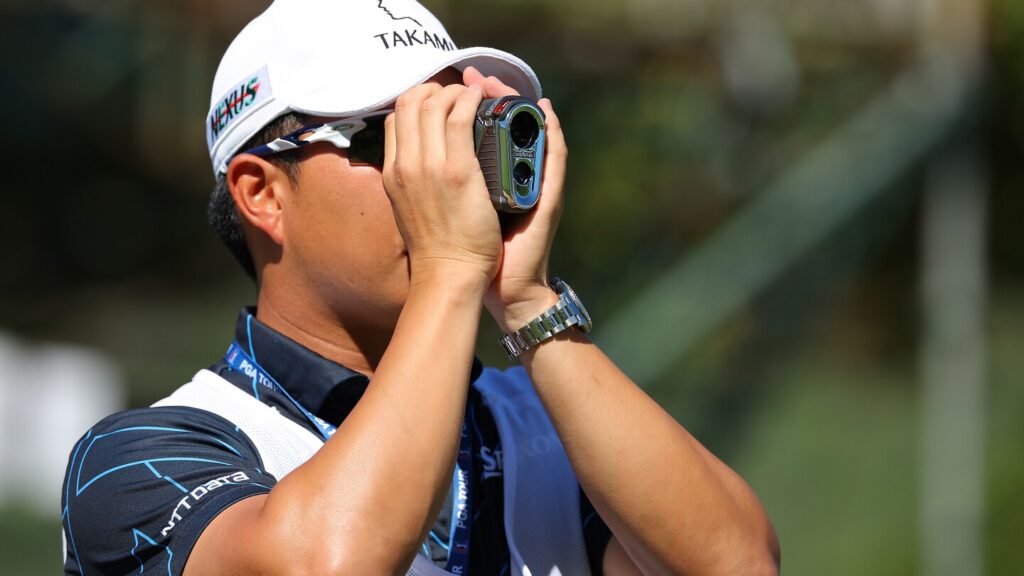HILTON HEAD ISLAND, S.C. – Observers will notice something is different at this week’s RBC Heritage.
The post-Masters celebration will have a solid field as the season’s sixth signature event, Harbour Town Golf Links will again play to its diabolical best, and the winner will again rank among the week’s best ball-strikers. What will be different is subtle yet significant.
The Heritage is the first event in a four-week, six-tournament stretch on the PGA Tour that will allow the use of distance-measuring devices (DMDs) in the circuit’s ongoing attempts to speed up play.
The use of DMDs is part of a larger plan to address pace of play — which was signaled out as an issue in the recent Fan Forward project — along with an adjustment to the Tour’s policy on timings starting this week on the Korn Ferry Tour.
“They’re going to have an extra tool in their toolbox for four weeks, and we’re interested in hearing, following that period, how was it? Do you feel it was beneficial? Do you feel it helped you with pace of play?” said Gary Young, a senior vice president of rules and competitions for the Tour. “I think that’s an important point to make about this. There is a beginning and an end to it, and then we’re going to take that time to really cram the data and take a look at it.”
Players and caddies will be allowed to use DMDs but only to identify “raw” distances, not slope or any other information provided by modern DMDs. Violation of that rule will result in a two-stroke penalty.
The PGA Championship, which is run by the PGA of America, already allows players to use DMDs during the tournament and the Korn Ferry Tour held a similar four-event trial in 2017, but officials hope to learn more about how using DMDs may speed up play.
“I don’t think there was anything concrete that came out of [the 2017 trial] data wise,” Young said. “There wasn’t a big improvement in round-time data, but this particular work group felt that field size had a lot to do with it and especially groupings.”
Earlier this year, the Tour established the “Speed of Play Working Group,” which includes Sam Burns, Adam Schenk and Jhonattan Vegas, to work with the Player Advisory Council on pace-of-play improvements.
“They felt during [two-ball] pairs it would be a struggle to stay up a little bit with the group ahead of you,” Young said. “Should they start to fall behind, they can quickly get a reference point and calculate yardage. It also may help the groups that are being timed keep up and make up time.”
PGA Tour commissioner Jay Monahan announced Tuesday aggressive adjustments to the circuit’s pace-of-play policy.
The DMDs trial is part of a wider pace-of-play focus Tour commissioner Jay Monahan announced last month at The Players Championship.
The Tour will also begin testing a new policy at the Lecom Suncoast Classic on the Korn Ferry Tour this week, and it’s already started on the PGA Tour Americas. The adjustment will remove what has essentially been a warning for a “bad time” and will now apply a one-stroke penalty for a “first offense.”
Most players don’t anticipate the use of DMDs to have much of an impact on pace of play and world No. 1 Scottie Scheffler suggested a more obvious approach to slow play.
“We’ve been using [DMDs] at the PGA the last couple years. Is it going to help pace of play? Maybe a few minutes. Will it be anything significant? No,” Scheffler said Tuesday at Harbour Town. “This tournament, what affects the pace of play is walking the golf course. I think we’re playing twosomes all week, so it will go from a five-hour round to maybe four hours or less.
“When you see the biggest changes in pace of play, it all comes from going from three guys to two guys in a pairing. It’s just easier to get around the golf course.”
Players and caddies anticipate using DMDs when dealing with shots that are well wide of playing corridors and it’s difficult to find a reference point to use a yardage book, as well as a way to confirm yardages on approach shots and tee shots on par 3s.
“I envision Tom [Hoge] standing in the fairway shooting [with a DMD] and I’ll be getting the numbers [traditionally] and we’ll do like we always do,” said James Edmondson, Hoge’s longtime caddie. “I’ll use it when we’re off-line, but we’re still going to use the fronts and the backs and the carries [yardages] in the book. If you don’t do that I think you’d get your sequence off. I think if you don’t it’s going to be too different for guys. Stick with old habits.”
The Tour also plans to make pace-of-play data available to the public but officials are still developing a list that addresses “average stroke time” with some context. For example, if a player averages 38 seconds to hit an approach shot but that number increases on Friday when the cut is looming or Sunday when a title is on the line.
Officials expect to have that list developed within the next month or two and it could be available to the public as early as this season.
Read the full article here



